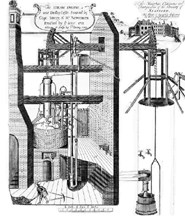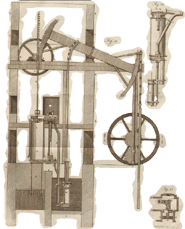


THE CULTURAL HERITAGE
KNOWLEDGE EXCHANGE HUB
EARLY ENGINE DATABASE
Explanation of the Database
This database is provided as a resource for researchers in any discipline, industrial sector or geographical area.
Anyone is free to use or adapt it to their work, provided the source is acknowledged in the form
“Source: The Early Engines Database compiled by John Kanefsky, 2024 version”and any second / third party copyrights are respected.
Users are requested to bear in mind that this database is a record of steam engine building (not utilisation) before the end of 1800. It records only the first erection of each engine, not what happened to it afterwards, although where important detail about later use is known this is explained in the comments section.
The database includes any stationary engine know to have started useful work in the British Isles before the end of 1800, even if it was very short lived. It does not include the small number of engines that powered boats or those erected outside the British Isles.
The database lists the details of each engine under these headings or columns:
- DATE
- The year in which the engine first started work, not its order date.
- In many cases the year of first operation is not known - this could have been many years earlier
and is designated by the letter “P”
- If the first operation date is approximate this is indicated by “c” (for “circa”)
(On the spreadsheet version these appear in a column titled “In or Before”) - LOCATION
- The physical location of the engine, where known and when first built. Often this is only the name of the operator or owner of the engine.
- OWNERS
- The person, company or organisation who owned it, where known.
- NUMBER
- Where several engines were erected at the same location or premises, these are numbered in the chronological sequence, as known / assumed, though for engines designated “P” this may be incorrect.
- TYPE
- Whether Newcomen pumping, Watt pumping, Watt Rotary, Common Rotary, Savery, or one of the many other configurations of engine used during the century.
- COUNTY
- The counties as they were immediately before the Local Government reorganisation of 1974 are used. A few engines are recorded only as “Scotland”or have no known county affiliation.
- INDUSTRY
- Fairly self-explanatory, though some difficulties arise. Some engines were located in premises where more than one industrial activity took place, eg flour milling and metal working.
- PURPOSE
- What the engine did when installed: Pumping water, recirculating over a water wheel, driving textile machinery, etc. Some engines had multiple purposes and some pumping engines were later converted to rotary action.
- MAKER
- Where known who was the designer, principal engineer or other instigator. (Boulton and Watt dominate this column).
- HORSEPOWER
- The recorded nominal or delivered horsepower as recorded by contemporaries or calculated by historians. This is often conjectural and generally not comparable between industrial sectors or individual engines. For B&W engines and many others this is usually a hypothetical calculation based on cylinder size.
- CYLINDER SIZE
- The internal diameter of the cylinder, to the nearest inch. Generally the most relevant comparator of the power of an engine.
- STROKE
- The designated length of the stroke, to the nearest foot. Not often reliable, except for Boulton and Watt engines.
- MOVED
- If known, whether the engine was moved to another location or scrapped (abandoned) or constitutes a major rebuild. (On the original spreadsheet version these are entered as “m”, “a” and “r”)
- POSSIBLE
- The existence of the engine is unconfirmed (Possible) or in some cases conjectural (Unlikely). Includes some engines first recorded after 1800. (On the original spreadsheet version these are entered as “P”, and “Unl”)
- CYLINDER MAKER
- Where known, whether the cylinder was cast by the pre-eminent foundries, Coalbrookdale and the Carron Company, or one of the many small brass foundries.
- REFERENCES
- The sources and provenance of the installation, in abbreviated form. A complete bibliography of sources is in compilation and will be added to this website in due course.
- COMMENTS
- Other useful details of context, where this illuminates the entry.
- GRID REFERENCE
- These detailed locational references of many engines (Eastings and Northings) were first compiled and added by Mike Gill, to whom profuse thanks. These are not intended to exactly pinpoint the engine house itself but aim to take you to location sufficiently close that if you had been there at the time it was working you would see it.
Contact - kanefskydatabase@gmail.com
Written permission is required to duplicate any of the content on this site.



